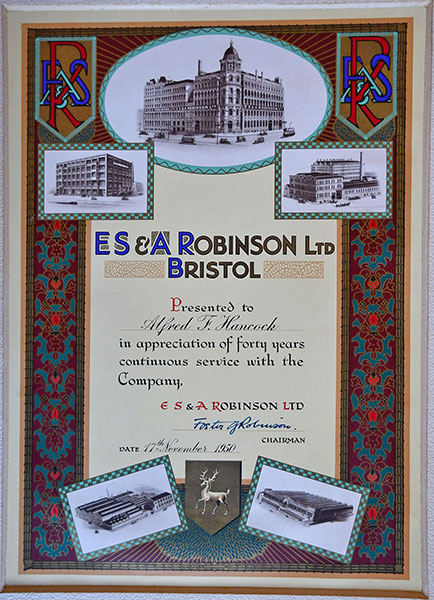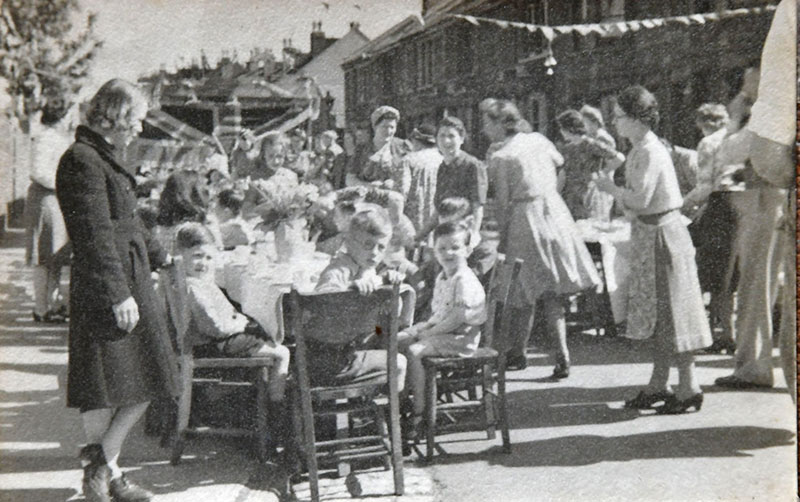Introduction
The history of E. S. & A. Robinson, paper bag manufacturers in south Bristol is fairly well documented on other sites. Now and then I would get inquiries and information about the company which I would put on the Bristol Help Wanted pages, such as the the one from Bob Drasner asking about paper bag manufacturers in general in April 2004. In December 2021, I received an email from Corrie Rutter whose relatives worked in the factory and who provided some very nice information and so this page was made.
This page is not a full history of the company but a collection of trivia and tidbits about it. See the Sources and Resources section at the bottom of the page for sites that provide better and more coherent histories.
Foster Robinson
Bob Drasner was looking into the history of bags and baggers epscially Foster Robinson, Paper Sacks Limited and Sir Malcolm Steward, Chairman of the Associated Portland Cement Manufacturers and the Fife paper Mills at Markinch. He was also interested in bags used for packing cement.
Foster Robinson became a director of E. S. & A. Robinson in 1910. Around that time he went to America to introduce a new satchel bag that Robinson's had developed. Around 1930 he was in America again. This time getting American bag manufacturers interested in a process where a cellophane pane could be inserted into a bag. These were very popular until bags made entirely from cellophane came onto the market and the process was bought to Britain and the Malago, Bedminster, Bristol factory.
Adelmer M. Bates was a Chicago based commercial traveller had an idea for packing salt into paper bags that had a valve in them. The idea couldn't work for salt, but it did for cement. In 1906 cloth, valved bags were introduced into America packing cement for Chams Cement Company. In 1908 the cloth was replaced by a single wall paper bag. In 1924, Mr Foster Robinson met Mr Bates. The two discussed making a 4 ply paper cement sack. Mr Robinson persuaded the LeHigh Portland Cement Company to order the new sacks. Later, Sir Malcolm Stewart, chairman of the Associated Portland Cement Manufacturer's also agreed to try the new bags. The Paper Sacks Ltd. then moved to Keynsham. In 1930 it moved to the "home of cement", Northfleet. Another factory was set up at Fife Paper Mills in Markinch and later another in Port Elizabeth in South Africa.
In another book, "The Merchant Venturers of Bristol" by Patrick McGrath (Society of Merchant Venturers of Bristol, 1975) it says that Mr. Foster Gotch Robinson was Senior Warden in 1942 and Master of the Society from 1943 to 1945. He was also heavily involved in the Society's policy of acquiring agricultural land, as he said "as a measure of prudence to guard against possible inflation." By 1951 the Society had land valued at around £1.5 million (Page 518). In 1946 he presented the Society with the saddle cloth and trappings used by Queen Elizabeth I during her visit to Bristol in 1574 (Page 464).
He also helped re-establish the Canynge Society in 1927, when St. Mary Redcliffe church needed restoration.
He was also a keen cricketer. The following comes from the CricInfo site...
He was born on 19th September 1880 at Sneyd Park, Clifton, Bristol and died on 31st October 1967, at Eastwood Manor, East Harptree, Somerset. He played for both London County (1900) and Gloucestershire (1903-1923) as a right hand batter and wicket keeper.
Wisden Cricketers' Almanack obituary
Sir Foster Gotch Robinson, who died on October 31, aged 87, captained Gloucestershire from 1919 to 1923, his best season being that of 1920, when he scored 798 runs, including two centuries, average 25.74. He later became a vice-president for the county. A capital wicketkeeper, he was in the Clifton XI from 1895 to 1900, but did not get a Blue at Oxford. For ten years from 1912 he captained Clifton C.C. A member of the Jockey Club, he was a well-known owner-breeder.
The Wikipedia site tells more of his interest in horses. In 1964, his horse Homeward Bound won the Epsom Oaks. It was ridden by Greville Starkey and trained by John Oxley. It finished the race in a time of 2.49.36 and came in at 100-7.
Bryan Bignell, who provided so much information for the St. George pages wrote that:
I was apprenticed at Strachan & Henshaw the old Whitehall works in Chalks road and started there in 1947. I mention this because they were part of the E. S. and A. Robinson Group and made envelope and bag making machines etc. Part of my apprenticeship was spent at the Fishponds Wax Paper works and another part at Colodense and the Cardboard Box factory in West Street, Bedminster.
In December 2021, I received an email from Corrie Rutter saying that "My husband’s late godmother Peggy Hancock lived in Bristol all her life and her parents worked there. Her father Alfred Francis Hancock had a long service certificate in 1950 with etchings of the various buildings" Corrie very kindly sent an image of the long servce certificate.

Alfred Francis Hancock's long service certificate from Robinsons
Corrie also very kindly provided the following picture. Peggy Hancock's mother, Mary, is the lady in glasses on the right.

VE Day street party in Bedminster. It is thought that the party was organized by the residents of Beauley Road and Coronation Road.
Sources & Resources
Robinsons of Bristol - Contains the full text of the 1844 - 1944 centenary book as well as a history of the cricketing side of the family
Wikipedia: E. S. & A. Robinson
This page created January 22, 2022; last modified January 25, 2022

